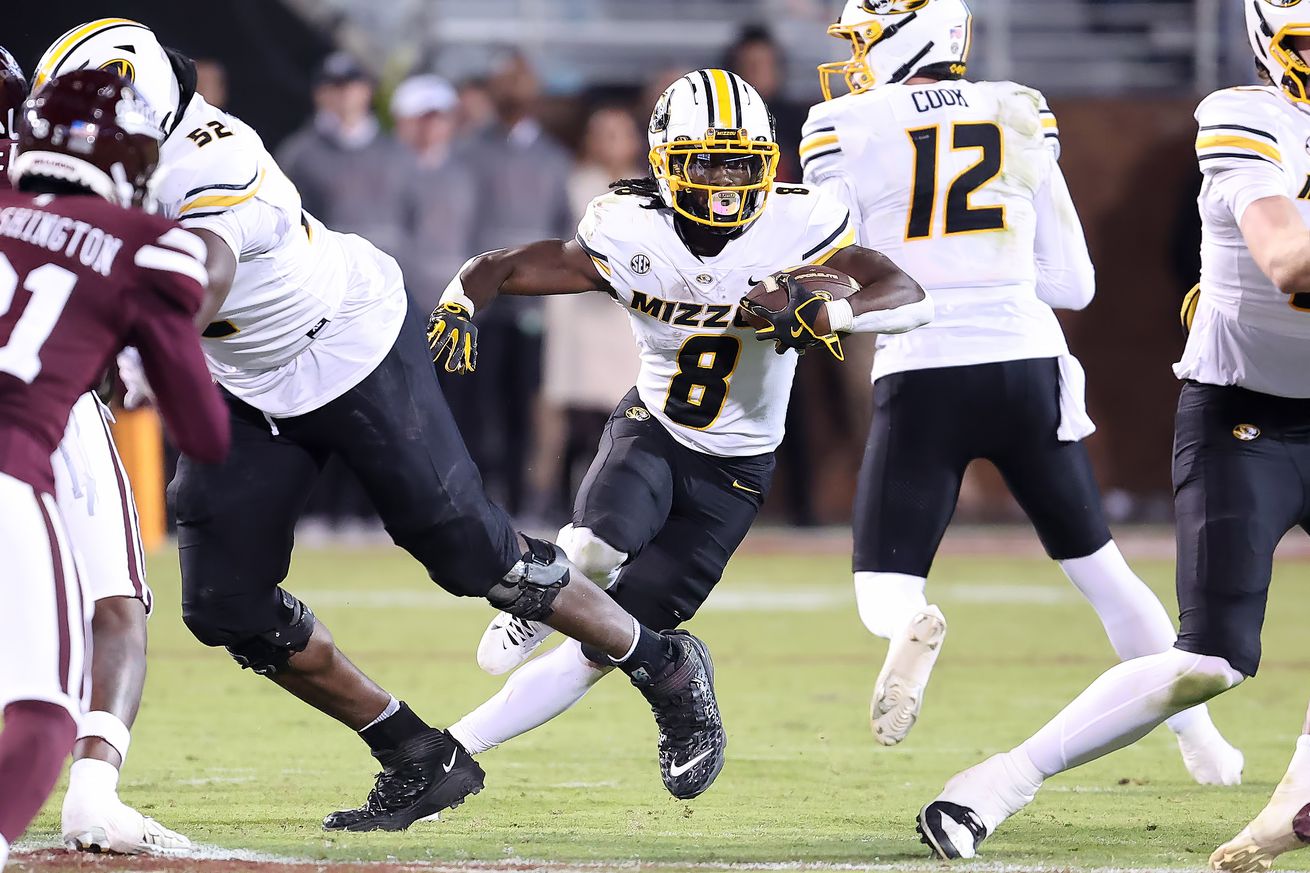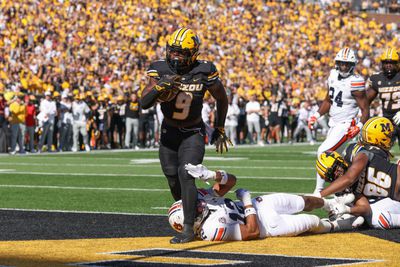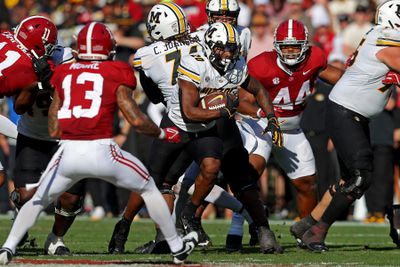
The Tigers have taken a running-back-by-committee approach to the ground game this year. And it has worked.
Entering the 2024 season, one of the biggest questions the Mizzou offense had to answer was how they were going to replace the SEC’s leading rusher and a top 10 Heisman candidate in Tiger legend Cody Schrader. Minus an obvious heir apparent to the “Workhorse Running Back Extraordinaire” position that Eli Drinkwitz has favored during his time at Mizzou, the coaching staff turned to the portal to answer that question.
Bringing in not one, but two 1,000-yard rushers from G5 programs, Eli Drinkwitz insisted that his offense would not try to replace the singular Cody Schrader with one player. Rather, they would use a holistic approach to matching the league-leading rushing production that the Tigers enjoyed in 2023.
To be honest, I was rather skeptical about this approach. I wasn’t necessarily skeptical that Mizzou would fail to run the ball productively this season. Tiger-led Eli Drinkwitz teams have always run the ball well, even with much worse talent than this one had on paper entering the season. Instead, I was skeptical that Drinkwitz and running backs coach Curtis Luper would stay true to their word and actually spread the wealth among a stable of backs this year. History was not on the side of Drinkwitz’s claims.
In previous four seasons under the current coaching regime, the leading rusher for the Tigers has averaged 162 carries more than the second-leading rusher:
- 2020: Larry Rountree (209 carries, 972 yards); Tyler Badie (48 carries, 242 yards)
- 2021: Tyler Badie (280 carries, 1,604 yards); Elijah Young (37 carries, 162 yards)
- 2022: Cody Schrader (170 carries, 768 yards); Brady Cook (113 carries, 585 yards)
- 2023: Cody Schrader (276 carries, 1,627 yards); Brady Cook (87 carries, 319 yards)
In fact, the only year that the difference in carries between the first and second-leading rushers was less than 190 was 2022. The year Cody Schrader broke onto the scene and took the lion’s share of carries in the second half of the year. To start that season, Nathaniel Peat was the lead back, but following a couple games of poor ball security, Cody Schrader took the reins and never looked back.
Starting with the Vanderbilt game in the second half of the season, Schrader averaged about 17 carries per game after only nine per game the first half of the year. So in effect, in four years of Eli Drinkwitz football, Mizzou has only used a team approach to running the ball for half of one season.
The past is history

Photo by Scott Winters/Icon Sportswire via Getty Images
With that historical backdrop, myself and many other Tiger fans and media were questioning whether or not the Mizzou offense would truly share the wealth of carries throughout the season. My bet was that the early non-conference games would see a relatively even split between Nate Noel and Marcus Carroll before the staff picking a favorite and riding that back the rest of the year. I also believed the underclassmen on the roster, such as Jamal Roberts, Kewan Lacy and Tavorus Jones would never see the field outside of special teams after the Buffalo (or perhaps UMASS) games.
To the staff (and the players’) credit, my assumptions were clearly wrong. Here is how the rushing splits break down through 11 games this year:
- Nate Noel: 147 carries, 779 yards, 5.3 ypc, 3 TD
- Marcus Carroll: 112 carries, 488 yards, 4.4 ypc, 10 TD
- Jamal Roberts: 48 carries, 199 yards, 4.1 ypc , 3 TD
- Brady Cook: 62 carries, 106 yards, 1.7 ypc, 4 TD
- Kewan Lacy: 23 carries, 104 yards, 4.5 ypc
*Luther Burden, Tavorus Jones, Drew Pyne, Mekhi Miller, Mookie Cooper and J.R. Blood combined for the remaining 46 carries and 180 yards.
It’s clear that Nate Noel is the lead back of the Tigers’ offense, and his carries would be higher had he not missed two games with injury. However, these rushing splits are much more evenly distributed than I would have ever guessed. That’s due in large part to sophomore Jamal Roberts and freshman Kewan Lacy playing well enough to earn playing time in conference games. That said, Marcus Carroll is more than holding his own, especially in his red zone production.
When it comes to whether or not the “by committee” approach to moving the ball on the ground can match the sterling effort Cody Schrader (and others) put up last year, I think the answer this late in the season is unequivocally “yes.”
- 2023 (13 games): 496 carries, 2,236 yards, 172.0 yards per game, 25 TDs, 4.5 yards per carry.
- 2024 (11 games): 438 carries, 1,856 yards, 168.7 yards per game, 22 TDs, 4.2 yards per carry.
With two games left to play, the Tigers are almost identical to the 2023 squad in yards per game, averaging 3.3 yards per game less. Considering whoever Mizzou’s bowl game opponent will basically be guaranteed to be worse defending the run than Ohio State was last year, it will almost be a guarantee that their yards per game average will end up even or perhaps even better than the 2023 team.

Photo by Jason Clark/Getty Images
What’s even more encouraging is that the coaching staff seems to be looking ahead to a Noel and Carroll-less 2025. By giving them significant snaps and carries in high-leverage spots, the coaches are setting up Jamal Roberts and Kewan Lacy to ostensibly be the two-headed monster on the ground for Mizzou next year. They’ve already started establishing roles for both players, with Roberts being the third down and short-yardage back while Lacy is the more explosive “between the 20s” sort of runner Nate Noel seems to be this season.
The transfer portal giveth and taketh away, so there very well may an unexpected addition to (or subtraction from) the running back room in the off-season. However, this season gives Tiger fans tangible proof that the Mizzou running game can remain a productive, if not elite, SEC rushing team without historic production from a single kaiju back like Tyler Badie or Cody Schrader. With a quarterback transition inevitable for next year, being able to lean on a stable running game will be vital in 2025 for continued Tiger success.